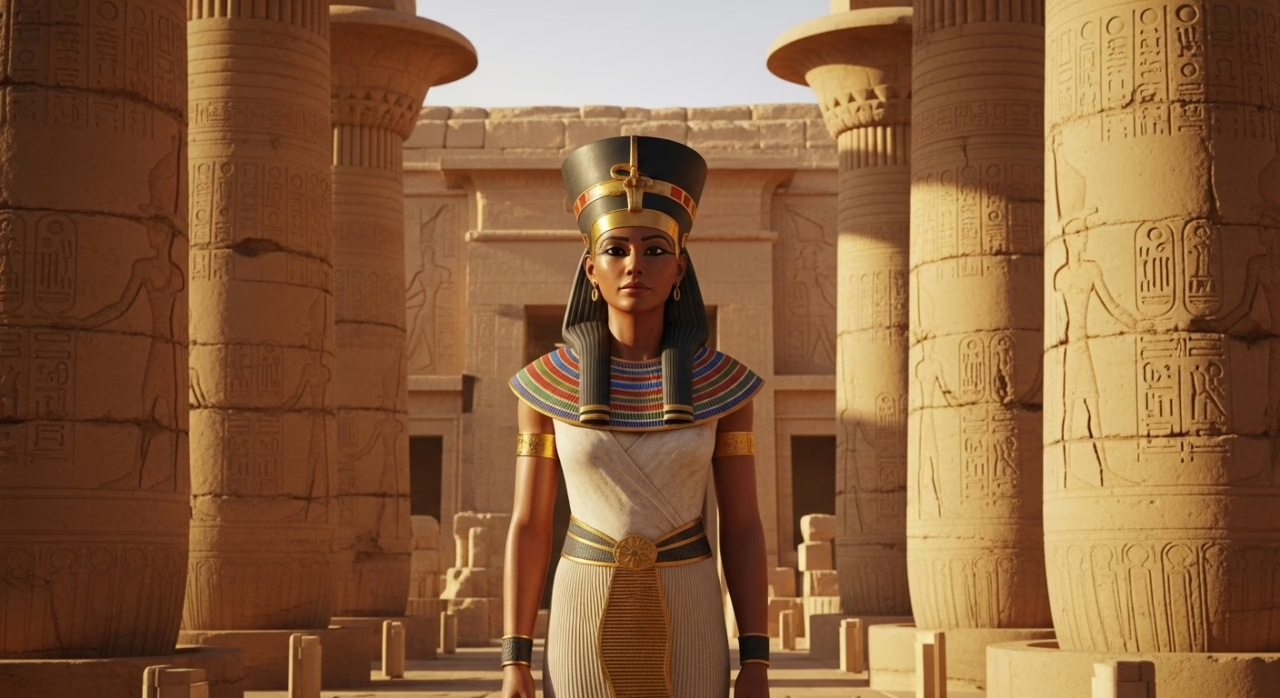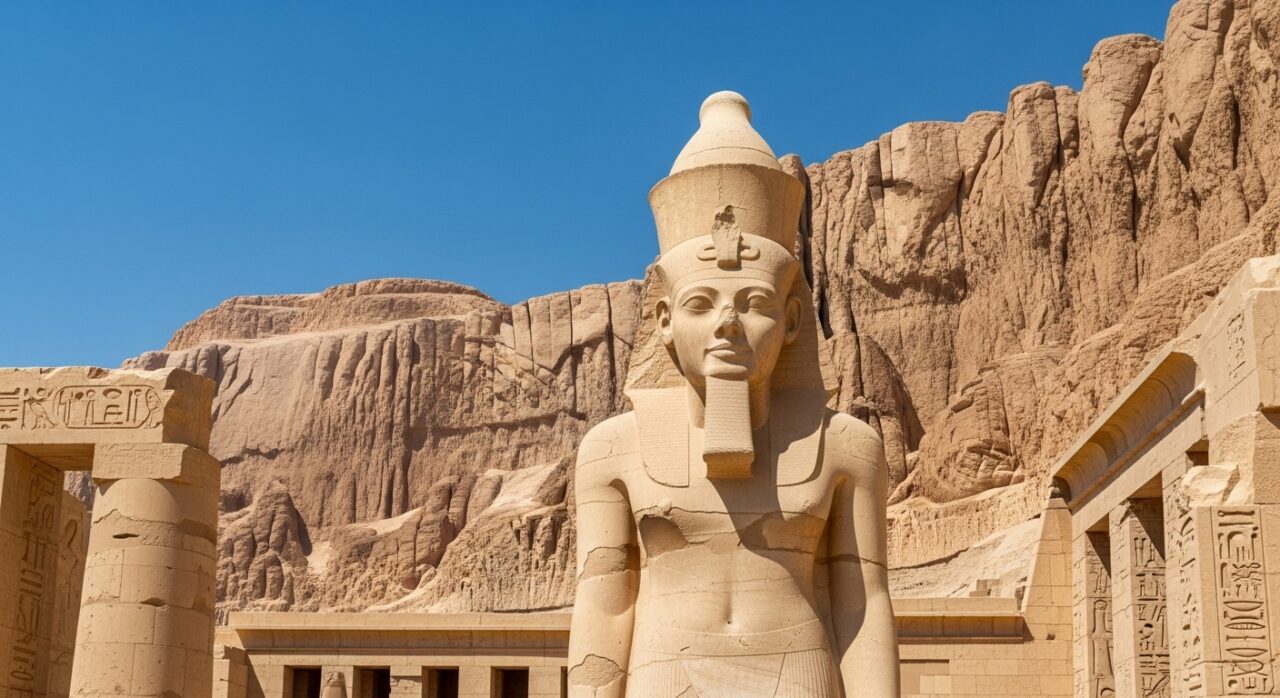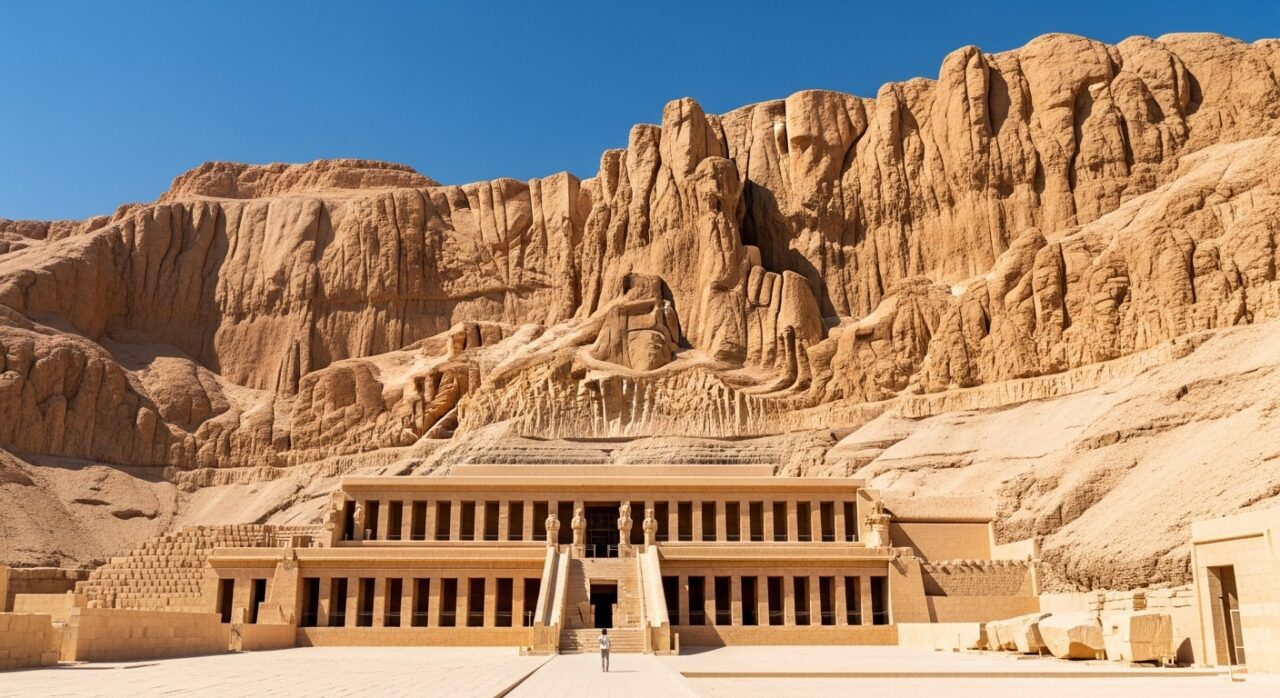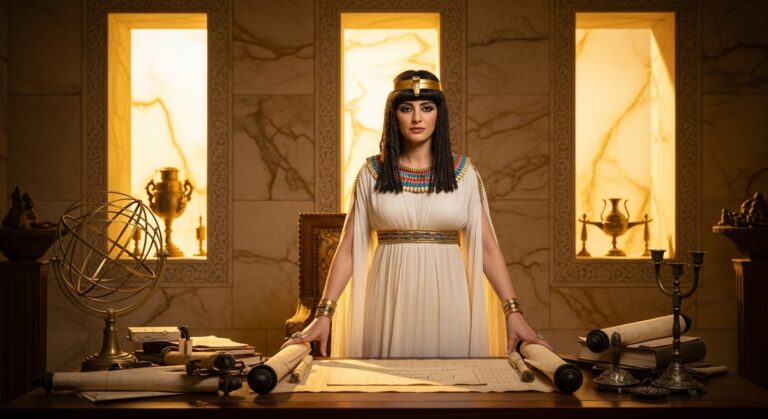Queen Hatshepsut: Egypt’s Forgotten Pharaoh

Queen Hatshepsut: Egypt’s Powerful Forgotten Ruler – Queen Hatshepsut, a pivotal yet often overlooked figure in ancient Egyptian history, ascended to power in a male-dominated society, challenging prevailing gender norms.
Her reign, marked by remarkable architectural feats and prosperous trade expeditions, raises questions about her legacy. Despite her achievements, Hatshepsut’s story faced significant erasure posthumously.
This raises intriguing inquiries about the forces that sought to obscure her contributions and the implications of her enduring influence in contemporary scholarship. What factors contributed to her historical obscurity?
Summary & Key Takeaways
Hide- Hatshepsut ascended as pharaoh in 1473 BCE, defying gender norms and adopting male regalia to solidify her rule.
- She is renowned for monumental architectural achievements, particularly her mortuary temple at Deir el-Bahari.
- Hatshepsut expanded trade networks, most notably through the expedition to Punt, securing valuable resources for Egypt.
- After her death, Thutmose III erased her legacy from historical records, leading to her being forgotten for centuries.
- Modern archaeological discoveries and feminist scholarship have revived interest in Hatshepsut's significant contributions and leadership as a female pharaoh.
Who Was Queen Hatshepsut?
Hatshepsut, born to King Thutmose I and Queen Ahmose around 1507 BCE, emerged from royal lineage with legitimate claims to power through Egypt’s matrilineal traditions.
Her transformation from queen regent to full pharaoh in 1473 BCE represented an extraordinary departure from Egyptian political norms, as she adopted the masculine royal iconography—including the ceremonial beard—while maintaining subtle references to her feminine identity in official portraiture.
Though not history’s first female ruler, Hatshepsut‘s methodical consolidation of authority through religious validation and architectural propaganda established her twenty-year reign as perhaps ancient Egypt’s most successful example of female kingship.
Early Life and Royal Lineage
Born circa 1507 BCE as the daughter of Pharaoh Thutmose I and Queen Ahmose, Hatshepsut‘s royal lineage positioned her within Egypt’s powerful 18th Dynasty amid the prosperity of the New Kingdom period.
Her unusual path to power began not through direct succession but through her role as queen consort and regent to her stepson Thutmose III, following the death of her husband and half-brother Thutmose II.
What distinguished Hatshepsut from other female regents in Egyptian history was her unprecedented transformation from queen regent to full pharaoh—adopting male royal regalia and titles while maintaining her feminine identity in private contexts, thereby challenging the gendered conventions of Egyptian kingship.
Hatshepsut’s Birth and Family Background
The royal lineage that would eventually produce one of Egypt’s most extraordinary rulers began in the early fifteenth century BCE, with the distinguished Thutmosid family of the 18th Dynasty.
Born circa 1508 BCE, Hatshepsut’s ancestral roots formed the foundation for her unprecedented rise to power.
- Daughter of Pharaoh Thutmose I and Queen Ahmose
- Half-sister and wife to Thutmose II
- Royal parentage through both maternal and paternal lines
- Noble heritage strengthened her legitimate claim to rule
- Family dynamics shaped by complex succession traditions
Ascension to Power: A Unique Path
After the death of Thutmose II in 1479 BCE, Egypt’s political landscape transformed in unprecedented ways, setting the stage for one of antiquity’s most remarkable power shifts.
Hatshepsut, confronting entrenched gender norms, navigated complex royal lineage dynamics with strategic political acumen. As regent for young Thutmose III, she gradually consolidated authority, employing legitimization strategies whose historical significance remains profound—a female pharaoh who ascended despite formidable ascension challenges.
Breaking Tradition: Egypt’s Female Pharaoh
Hatshepsut’s unprecedented coronation as pharaoh in 1473 BCE shattered ancient Egypt’s patriarchal governance structure, challenging millennia of male-dominated succession.
Despite her female identity, she claimed the throne not as queen consort but as king—complete with the ceremonial false beard, royal regalia, and masculine titles that traditionally symbolized pharaonic authority.
Her audacious ascension illuminates the complex interplay between gender and power in Egyptian society, where cosmic order (ma’at) typically limited women’s political authority while allowing Hatshepsut, through careful political maneuvering and divine claims, to transcend these boundaries.
Hatshepsut’s Coronation and Claim to Throne
In 1479 BCE, amidst the political tumult following Thutmose II’s death, a remarkable coronation ceremony transformed Egypt’s royal succession narrative forever.
Hatshepsut, transcending her regent status, orchestrated an unprecedented ascension through divine right and astute political maneuvering.
- Claimed divine selection by Amun-Ra himself
- Adopted masculine royal iconography while maintaining feminine titles
- Executed elaborate symbolic rituals affirming her legitimacy
- Secured support from influential temple priesthoods
- Retroactively altered royal chronologies to strengthen her position
Gender and Power in Ancient Egypt
While most ancient societies rigidly confined women to domestic and ceremonial roles, Egypt’s distinctive gender dynamics created rare pathways to formal power that Hatshepsut ultimately transformed into unprecedented authority.
Egyptian societal norms permitted female leadership in limited capacities, though historical narratives often minimized women’s contributions.
Hatshepsut’s reign challenged these power dynamics, establishing a precedent that disrupted conventional gender roles and reshaped the pharaonic tradition.
Achievements and Legacy of Hatshepsut
Hatshepsut’s reign was characterized by ambitious architectural undertakings, most prominently her mortuary temple at Deir el-Bahari, which stands as a symbol of her vision and the technical sophistication of Egyptian engineering.
She strategically expanded Egypt’s commercial network through maritime expeditions to distant lands, particularly her famous trading mission to Punt that secured exotic goods like myrrh, ebony, and gold.
These economic initiatives, documented in temple inscriptions and pictorial reliefs, not only bolstered Egypt’s prosperity but also reinforced Hatshepsut’s legitimacy as pharaoh—a calculated political maneuver that merged economic pragmatism with divine mandate.
Monumental Building Projects
Among Hatshepsut’s most enduring legacies, the mortuary temple at Deir el-Bahri stands as a masterpiece of architectural innovation, with its terraced design harmoniously integrated into the natural landscape.
Her magnificent obelisks, particularly the towering monoliths at Karnak Temple, demonstrated not only her political authority but also Egypt’s technological prowess, as these 97-foot granite monuments were the tallest in the world at that time.
Throughout her reign, Hatshepsut commissioned numerous statues depicting herself in traditional pharaonic regalia—sometimes with feminine features, other times with the masculine attributes of kingship—visually reinforcing her legitimate claim to the throne while creating an iconographic puzzle that continues to intrigue Egyptologists.
The Temple of Deir el-Bahri
The Temple of Deir el-Bahri stands as perhaps the most magnificent architectural achievement of Hatshepsut’s reign, a tribute to her ambitious vision and political acumen.
This terraced sanctuary, carved into Theban limestone cliffs, merged architectural innovation with sacred landscape significance.
- Colonnade halls ascending three dramatic levels
- Relief carvings depicting her divine birth and Punt expedition
- Shrine to Hathor with symbolic cow-headed columns
- Ritualistic pathways for ceremonial processions
- Astronomical alignments with winter solstice
Hatshepsut’s Obelisks and Statues
Monumental obelisks and commanding statuary punctuated the landscape of ancient Egypt during the reign of the female pharaoh who dared to redefine royal iconography.
Hatshepsut’s obelisks, towering granite sentinels at Karnak Temple, embodied her architectural innovations while expressing religious significance.
Her statues’ symbolism evolved from feminine representations to masculine pharaonic imagery—a calculated artistic transformation that liberated her from gender constraints within Egypt’s divine kingship tradition.
Trade Expeditions and Economic Growth
Hatshepsut’s most renowned economic achievement, her expedition to the mysterious land of Punt, expanded Egypt’s trade networks beyond previously established boundaries and secured valuable resources including myrrh trees, ebony, gold, and exotic animals.
The successful voyage, meticulously documented on the walls of her mortuary temple at Deir el-Bahari, represented not merely a commercial venture but a strategic demonstration of Egypt’s international reach under her leadership.
Through such ambitious trade initiatives, Hatshepsut transformed Egypt’s economy, establishing a period of unprecedented prosperity that strengthened the nation’s position as a dominant Mediterranean power during the 18th Dynasty.
The Famous Expedition to Punt
Sailing across the Red Sea toward mysterious lands, Hatshepsut’s ambitious trading expedition to Punt stands as perhaps the most celebrated achievement of her reign.
The maritime exploration, meticulously documented at Deir el-Bahari, launched ancient shipping beyond conventional Punt trade routes, yielding:
- Myrrh trees for temple incense
- Gold and ebony for royal treasuries
- Exotic animals unknown to Egyptians
- Diplomatic relations with distant kingdoms
- Unprecedented cultural exchange between civilizations
Impact on Egypt’s Wealth and Prosperity
While the monoliths and temples of Hatshepsut’s reign visually dominate Egypt’s architectural landscape, her economic policies transformed the kingdom’s prosperity with equal permanence.
Under her guidance, extensive Trade Networks flourished, enabling unprecedented Wealth Distribution across social strata.
Agricultural Advances, spurred by foreign botanical imports, bolstered food security, while her Economic Influence catalyzed Cultural Prosperity through patronage of artisans and intellectuals.
The Mystery of Hatshepsut’s Disappearance from History
Following Hatshepsut’s death around 1458 BCE, her successor Thutmose III systematically removed her name and image from monuments throughout Egypt, effectively erasing her twenty-two-year reign from official historical narratives.
This calculated damnatio memoriae—a deliberate obliteration of memory—remained largely successful until the late 19th century, when archaeologists began noticing peculiar inconsistencies in royal chronologies and defaced inscriptions.
The subsequent excavation of her mortuary temple at Deir el-Bahari in 1903, coupled with meticulous analysis of surviving artifacts bearing her cartouche, gradually reconstructed the remarkable story of a female pharaoh intentionally obscured for over three millennia.
Erasure from Historical Records
Following Hatshepsut’s death around 1458 BCE, her successor Thutmose III systematically removed her name from monuments throughout Egypt, chiseling away cartouches and replacing her image with those of male predecessors.
This calculated erasure, occurring approximately twenty years into Thutmose’s independent reign rather than immediately after her death, suggests political motives beyond mere vengeance—perhaps an attempt to legitimize his own lineage or realign Egyptian historical narratives with traditional male pharaonic succession.
Scholars continue to debate whether this historical obliteration stemmed from personal animosity, dynastic concerns, or theological imperatives regarding the proper order of kingship in ancient Egyptian cosmology.
Thutmose III and the Attempt to Erase Her Name
Thutmose III launched one of history’s most systematic campaigns of political erasure approximately twenty years after Hatshepsut’s death, methodically chiseling her name from monuments and replacing her image with offerings or blank stone throughout Egypt.
This Royal Erasure exemplifies ancient Power Struggles that challenge modern historical understanding.
- Cartouches bearing her name were deliberately defaced
- Her statues were smashed and buried
- Official king-lists omitted her reign entirely
- Male pronouns replaced feminine references
- Her mortuary temple suffered targeted destruction
Reasons Behind the Historical Silence
Although historians have debated the motives behind Hatshepsut’s erasure for centuries, the reasons for her systematic removal from Egypt’s historical record remain tantalizingly complex.
Gender bias within dynastic succession customs partially explains this historical neglect, complemented by Thutmose III’s political motivations to legitimize his rule.
Cultural amnesia followed, perpetuated by scholarly oversight that only recently began excavating the remarkable story of this female pharaoh from antiquity’s shadows.
Rediscovery of Hatshepsut
Nearly three and a half millennia after her reign, Hatshepsut emerged from historical obscurity through a series of groundbreaking archaeological discoveries in the late 19th and early 20th centuries.
Excavations at Deir el-Bahari revealed not only her mortuary temple‘s magnificence but also numerous artifacts bearing her likeness and cartouches, challenging scholars to reassess her historical significance.
The definitive breakthrough came in 2007 when Egyptologist Zahi Hawass identified a previously anonymous mummy as Hatshepsut herself through meticulous CT scans and DNA analysis, resolving one of Egyptology’s most persistent mysteries.
Archaeological Discoveries Uncovering Her Story
For over twenty-two centuries, Hatshepsut’s extraordinary legacy lay buried beneath Egypt’s golden sands, her name meticulously chiseled from monuments and her images deliberately defaced in what scholars now recognize as one of antiquity’s most thorough damnatio memoriae campaigns.
Modern archaeological methods have illuminated her remarkable reign through:
- Tomb excavations revealing unprecedented female authority symbolism
- Cartouche analyses demonstrating historical context of gender dynamics
- Temple reconstruction enhancing interpretation of royal propaganda
- Funerary artifact symbolism analysis providing cultural insights
- DNA testing yielding modern implications for dynastic understanding
Identification of Hatshepsut’s Mummy
Tantalizing archaeological intrigue swirled around Hatshepsut’s physical remains for generations, with her mummy representing perhaps the most elusive piece in the complex puzzle of her historical erasure.
In 2007, forensic analysis finally linked a previously unidentified mummy from tomb KV60 to Hatshepsut’s identity through a singular molar tooth found in her burial site, liberating her legacy from centuries of deliberate obscurity.
Personal Life and Controversies
Hatshepsut’s relationship with her nephew and stepson, Thutmose III, remains a subject of scholarly debate, vacillating between interpretations of mentorship and theories of bitter rivalry.
Her unconventional self-representation in statuary and reliefs—often depicted with the traditional beard and masculine regalia of pharaonic power—challenges modern perspectives on gender in ancient Egyptian political theology.
These iconographic choices, rather than suggesting gender dysphoria through modern lenses, likely reflected pragmatic adaptations to religious and political requirements of kingship in a society where divine authority had been exclusively coded as masculine.
Relationship with Thutmose III
The relationship between Hatshepsut and her stepson Thutmose III oscillated between cooperative governance and latent rivalry, evidenced by conflicting archaeological records that depict both shared ceremonial appearances and separate spheres of influence.
Scholars continue to debate whether Hatshepsut acted as a legitimate guardian regent or as a political usurper who relegated the young king to secondary status during her twenty-year reign.
Intriguing evidence from the Temple at Deir el-Bahari suggests that, despite later attempts to erase Hatshepsut from official history, their co-regency maintained Egypt’s stability through what may have been a pragmatic, if uneasy, political partnership.
Co-ruler or Rival?
How did the complex relationship between Hatshepsut and her stepson, Thutmose III, evolve from nominal co-regency into what some scholars characterize as thinly veiled antagonism?
- Co-ruler dynamics initially allowed shared governance
- Political alliances shifted as Thutmose III matured
- Power struggles remained largely beneath ceremonial facades
- Rival claims to legitimacy emerged in temple inscriptions
- Both maintained public unity despite escalating private tensions
Exploring Their Complex Relationship
While maneuvering through the treacherous waters of ancient Egyptian politics, the relationship between Hatshepsut and her stepson, Thutmose III, evolved into a tapestry woven with threads of collaboration, rivalry, and ultimately, a profound struggle for power.
This dynamic reflected shifting power dynamics, gender roles, and royal lineage, shaping historical narratives that continue to influence Egypt’s cultural legacy and understanding of female leadership.
Depictions and Gender Representation
Hatshepsut’s frequent portrayal as a male figure in art and inscriptions reveals complex layers of gender representation within her reign.
This strategic choice not only underscored her authority as a pharaoh but also aligned with the prevailing symbolism of masculinity associated with power in ancient Egypt.
Why Hatshepsut Often Appeared as Male
Throughout ancient Egyptian history, the complexities of gender representation are vividly illustrated in the case of Hatshepsut, whose reign as pharaoh presents a fascinating study in the intersection of power, identity, and societal expectations.
- Emphasis on masculine imagery
- Assertion of royal authority
- Conformity to gender norms
- Utilization of cultural symbolism
- Navigation of power dynamics
These factors influenced her portrayal.
Symbolism Behind Her Masculine Depictions
The masculine depictions of Hatshepsut serve as a compelling lens through which to explore the intricate symbolism embedded in her reign and personal narrative.
By utilizing masculine imagery, she challenged traditional gender representation, asserting her royal authority within a patriarchal society.
This cultural symbolism, when viewed in historical context, reveals her strategic manipulation of gender roles to solidify power and secure her legacy.
Hatshepsut’s Enduring Influence
Hatshepsut’s legacy continues to shape contemporary discussions surrounding female leadership, challenging traditional gender norms and inspiring a reevaluation of women’s roles in history.
As modern representations in popular media increasingly highlight her narrative, they serve not only to illuminate her contributions but also to reflect broader societal shifts regarding the acceptance of women in positions of power.
This enduring influence invites a deeper examination of how historical figures can resonate with current cultural movements, fostering both admiration and critical inquiry into the complexities of leadership.
Changing Perspectives on Female Leadership
Hatshepsut’s reign, often overshadowed by her male counterparts, has garnered renewed attention as modern interpretations challenge traditional narratives of female leadership in ancient Egypt.
By examining her successful strategies and the complexities of her rule, contemporary scholars highlight her role as a pioneering figure who inspires women leaders today.
Consequently, Hatshepsut not only reshapes historical perspectives but also serves as a symbol of resilience and capability in leadership, transcending time and cultural boundaries.
Modern Interpretations of Hatshepsut’s Reign
Although often overshadowed by her male counterparts, the reign of Egypt’s female pharaoh has increasingly garnered attention in contemporary scholarship, reflecting a profound shift in the understanding of female leadership throughout history.
Key themes emerging include:
- Feminist interpretations of power dynamics
- Revision of historical narratives
- Reevaluation of leadership archetypes
- Legacy reclamation in modern discourse
- Exploration of her cultural significance
Inspiration for Women Leaders Today
The legacy of Egypt’s female pharaoh continues to resonate in contemporary discussions surrounding female leadership, illuminating pathways for modern women leaders.
Hatshepsut embodies historical resilience, offering invaluable leadership lessons through her journey of overcoming obstacles.
Her story serves as an inspiring role model for female empowerment, encouraging today’s leaders to embrace their potential and challenge conventions, fostering a future where women thrive in positions of authority.
Cultural Representations in Popular Media
Hatshepsut’s legacy has transcended time, finding resonance in various forms of popular media, including films, literature, and documentaries that explore her remarkable reign.
As contemporary audiences engage with her story, they uncover not only the complexities of her leadership but also the broader themes of gender and power dynamics in ancient Egypt.
This increasing representation reflects a growing fascination with Hatshepsut, underscoring her enduring influence as a symbol of female empowerment and historical intrigue.
Films, Literature, and Documentaries Featuring Hatshepsut
While numerous figures from ancient Egypt have captured the imagination of filmmakers and writers alike, few have inspired as much intrigue and interpretation as the female pharaoh who ruled during the 18th Dynasty.
- Hatshepsut in film
- Literature portrayals examining her legacy
- Documentary insights into her reign
- Historical accuracy in modern adaptations
- Artistic interpretations that challenge traditional narratives
These representations underscore her enduring influence.
Her Growing Popularity in Modern Culture
In recent years, an increasing fascination with Hatshepsut has emerged within popular culture, reflecting both a growing recognition of her historical significance and a broader interest in female leadership throughout history.
Hatshepsut’s influence as a feminist icon is evident in modern adaptations, which highlight her cultural significance and offer valuable leadership lessons.
These adaptations inspire contemporary audiences to explore the complexities of power and gender.
Unanswered Questions and Continuing Research
As ongoing excavations and investigations into Hatshepsut’s life and reign continue to unfold, numerous questions linger regarding the complexities of her rule and the subsequent erasure of her legacy.
The potential for future discoveries, particularly at sites such as Deir el-Bahari, could considerably enhance understanding of her impact on ancient Egypt, illuminating the cultural and political dynamics of her era.
Researchers remain hopeful that emerging evidence will not only clarify Hatshepsut’s contributions but also challenge existing narratives about power and gender in the ancient world.
Ongoing Excavations and Investigations
Current archaeological projects focused on Hatshepsut’s reign are yielding new insights, yet many questions about her life and death remain unanswered.
Scholars are exploring innovative theories that challenge traditional narratives, suggesting complexities in her rule and eventual demise.
As investigations continue, the potential to uncover further artifacts and historical context not only enriches the understanding of Hatshepsut’s legacy but also invites speculation about the broader implications for ancient Egyptian history.
Current Archaeological Projects
Archaeological endeavors surrounding Hatshepsut, Egypt’s enigmatic female pharaoh, continue to yield fresh insights and pose lingering questions, marking a lively intersection of past and present scholarship.
Current projects focus on:
- Advanced archaeological techniques
- Promising excavation sites
- Uncovering historical artifacts
- Securing research funding
- Fostering interdisciplinary collaboration
These efforts aim to deepen understanding of her reign and legacy, illuminating previously obscured aspects of her extraordinary life.
New Theories About Her Life and Death
What insights might recent excavations reveal about the life and death of Hatshepsut, the remarkable female pharaoh who defied the conventions of her time?
Scholars increasingly explore Hatshepsut’s legacy through the lens of ancient gender dynamics and royal power struggles, as ongoing investigations seek to unravel burial site mysteries, prompting potential historical narrative shifts that may redefine her role in Egypt’s storied past.
Future Discoveries
Future discoveries regarding Hatshepsut hold the potential to reshape contemporary understandings of Ancient Egypt, as ongoing research may uncover new evidence that has eluded scholars for centuries.
The nuanced complexities of her reign, including her unique portrayal in art and architecture, invite further exploration, particularly in light of recent technological advancements in archaeology.
As excavations continue and interdisciplinary approaches evolve, the enigmatic legacy of this remarkable pharaoh may reveal insights that challenge long-held perceptions of gender and power in a historically male-dominated society.
Potential for New Evidence
While the tombs and monuments of ancient Egypt have long been subjects of fascination, the life and reign of Hatshepsut remain shrouded in mystery, inviting further exploration into her legacy.
Potential for new evidence includes:
- Newly uncovered artifacts illuminating her reign
- Historical document analysis revealing untold stories
- Ancient inscriptions review to decode her narrative
- Interdisciplinary research collaboration enhancing understanding
- Digital archaeology advancements reshaping perspectives
Impact on Our Understanding of Ancient Egypt
As scholars explore deeper into the legacy of Hatshepsut, the complexities of her reign not only challenge prevailing narratives but also illuminate broader themes within ancient Egyptian history.
Hatshepsut’s influence on female leadership, coupled with her subversion of ancient gender roles and innovative royalty symbolism, invites ongoing research that seeks to redefine historical narratives, ultimately enriching our understanding of this enigmatic pharaoh and her era.
Wrapping Up
To sum up, Queen Hatshepsut’s reign stands as a reflection of the complexities of gender and power in ancient Egypt, marked by her remarkable architectural innovations and trade advancements.
Remarkably, she orchestrated trade expeditions that expanded Egypt’s wealth, with one voyage to Punt yielding a reported 31 tons of myrrh alone.
Yet, the enigma of her posthumous erasure invites ongoing inquiry, as scholars continue to unravel the layers of her legacy, ensuring that this extraordinary pharaoh remains a focal point of historical discourse.
- Arnold, D. (2005). The temple of Hatshepsut at Deir el-Bahari. The Metropolitan Museum of Art.
- Bryan, B. M. (2000). The 18th Dynasty before the Amarna period. In I. Shaw (Ed.), The Oxford history of ancient Egypt (pp. 218–271). Oxford University Press.
- Callender, G. (2003). Hatshepsut: First female pharaoh. Ancient Egypt, 4(3), 34–41.
- Cooney, K. M. (2014). The woman who would be king: Hatshepsut’s rise to power in ancient Egypt. Crown Publishing Group.
- Dorman, P. F. (2006). The monuments of Hatshepsut’s reign. In H. Roth (Ed.), Hatshepsut: From queen to pharaoh (pp. 86–112). The Metropolitan Museum of Art.
- Grimal, N. (1992). A history of ancient Egypt (I. Shaw, Trans.). Blackwell Publishing.
- Naville, E. (1894–1908). The temple of Deir el-Bahari (Volumes I–VI). Egypt Exploration Fund.
- Redford, D. B. (2003). Hatshepsut: The female pharaoh. KMT: A Modern Journal of Ancient Egypt, 14(2), 38–49.
- Robins, G. (1993). Women in ancient Egypt. Harvard University Press.
- Roth, A. M. (2005). Gender roles in ancient Egypt. In B. W. Lesko (Ed.), Women’s earliest records from ancient Egypt and western Asia (pp. 15–31). Eisenbrauns.
- Sullivan, M. D. (2007). Erasure of a queen: Hatshepsut’s erasure in history. Journal of Egyptian History, 1(1), 77–100. https://doi.org/10.1163/187416607783236846
- Tyldesley, J. (1996). Hatchepsut: The female pharaoh. Penguin Books.
- Wegner, J. (2007). The mortuary temple of Senwosret III at Abydos. University of Pennsylvania Museum Publications.
- Willems, H. (2001). The social context of Hatshepsut’s reign. Journal of Near Eastern Studies, 60(3), 163–183. https://doi.org/10.1086/511812
- Ziegler, C. (2007). Statues of Hatshepsut: A re-evaluation. In C. Roehrig (Ed.), Hatshepsut: From queen to pharaoh (pp. 210–231). The Metropolitan Museum of Art.







